Chinese dumplings are a culinary treasure, encompassing a wide array of flavors, textures, and regional specialties. From the iconic jiaozi to the delicate xiaolongbao, the world of types of Chinese dumplings is as vast as it is delicious.
Each dumpling tells a story of cultural heritage and culinary expertise, making them a beloved dish both in China and around the globe. Join us on a journey to explore the fascinating world of types of Chinese dumplings, where traditions meet innovation and flavors collide to create an extraordinary gastronomic experience.
What are Chinese dumplings?
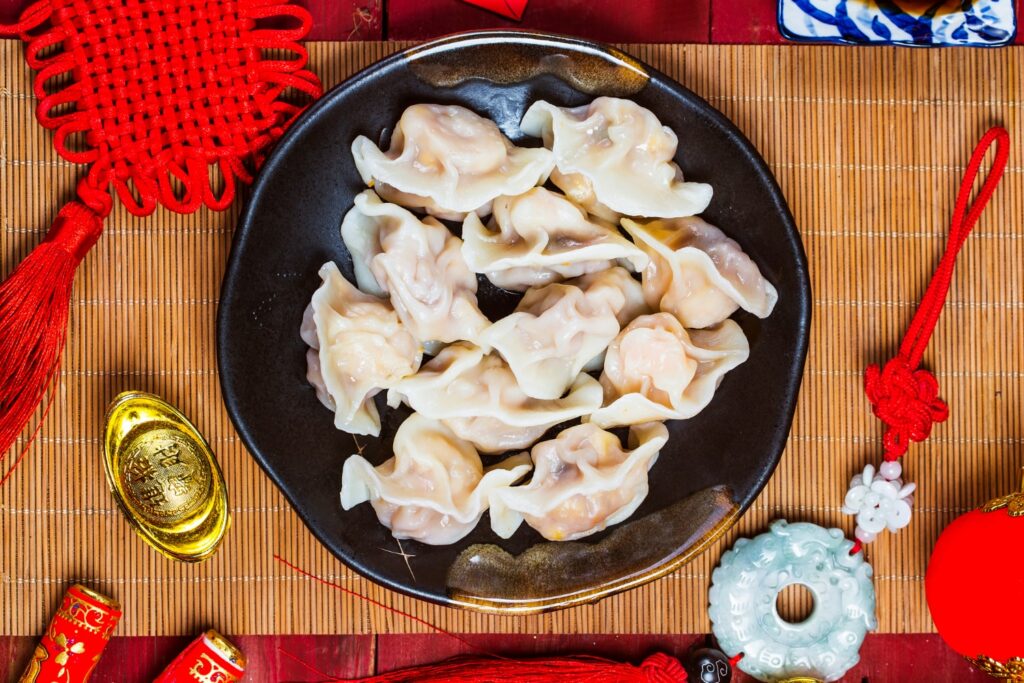
Chinese dumplings are a beloved and iconic dish in Chinese cuisine. They consist of various types of fillings wrapped in a thin dough, which are then steamed, boiled, or pan-fried to perfection. Dumplings hold great cultural significance in Chinese tradition, often symbolizing wealth, prosperity, and family togetherness, especially during festivals like Chinese New Year.
Historically, dumplings are believed to have originated thousands of years ago in China. Legend has it that Zhang Zhongjing, a renowned physician during the Eastern Han Dynasty, created the first dumplings as a remedy for frostbitten ears. The dumplings were shaped like ears and filled with warming ingredients. Since then, dumplings have become a staple in Chinese culinary culture.
Over time, dumpling-making techniques spread across different regions of China, leading to the development of various regional specialties. Each region has its own unique styles, flavors, and cooking methods, resulting in a rich tapestry of dumpling varieties. From the hearty jiaozi of northern China to the delicate xiaolongbao of Shanghai, Chinese dumplings showcase the diverse culinary heritage and creativity of the country’s vast and dynamic food culture.
Key ingredients
Key ingredients commonly used in Chinese dumplings include:
- Ground meat (such as pork, chicken, or beef)
- Shrimp or seafood
- Vegetables (such as cabbage, Chinese chives, or mushrooms)
- Tofu or soy-based products (for vegetarian or vegan dumplings)
- Seasonings (including soy sauce, ginger, garlic, and sesame oil)
- Rice or wheat flour for the dumpling wrappers
- Eggs (used as a binding agent or for egg wash)
- Aromatic herbs and spices (such as cilantro, green onions, or Sichuan peppercorns)
- Dried or preserved ingredients (like dried shrimp, dried mushrooms, or salted vegetables) for added flavor
- Oils and fats (such as vegetable oil or lard) for cooking and enhancing the dumpling’s texture and flavor.
These key ingredients can be combined in various ways to create a diverse and delicious range of Chinese dumplings enjoyed across different regions and culinary traditions.
How many types of Chinese dumplings are there?
There are countless types of Chinese dumplings, each with its own distinct characteristics and flavors. While it’s challenging to provide an exact number, the variety of Chinese dumplings is truly extensive. Some popular types include jiaozi, wonton, shui jiao, guo tie, xiaolongbao, zhongzi, tang yuan, shaomai, lion’s head meatballs, and zongzi, among many others. Additionally, there are fusion and modern interpretations, vegetarian options, and regional specialties that further expand the range of Chinese dumplings available. The sheer diversity of fillings, wrappers, cooking methods, and regional influences ensures that there is a Chinese dumpling to suit every palate and preference.
Classic Chinese dumplings
Jiaozi: The Iconic Dumplings from Northern China
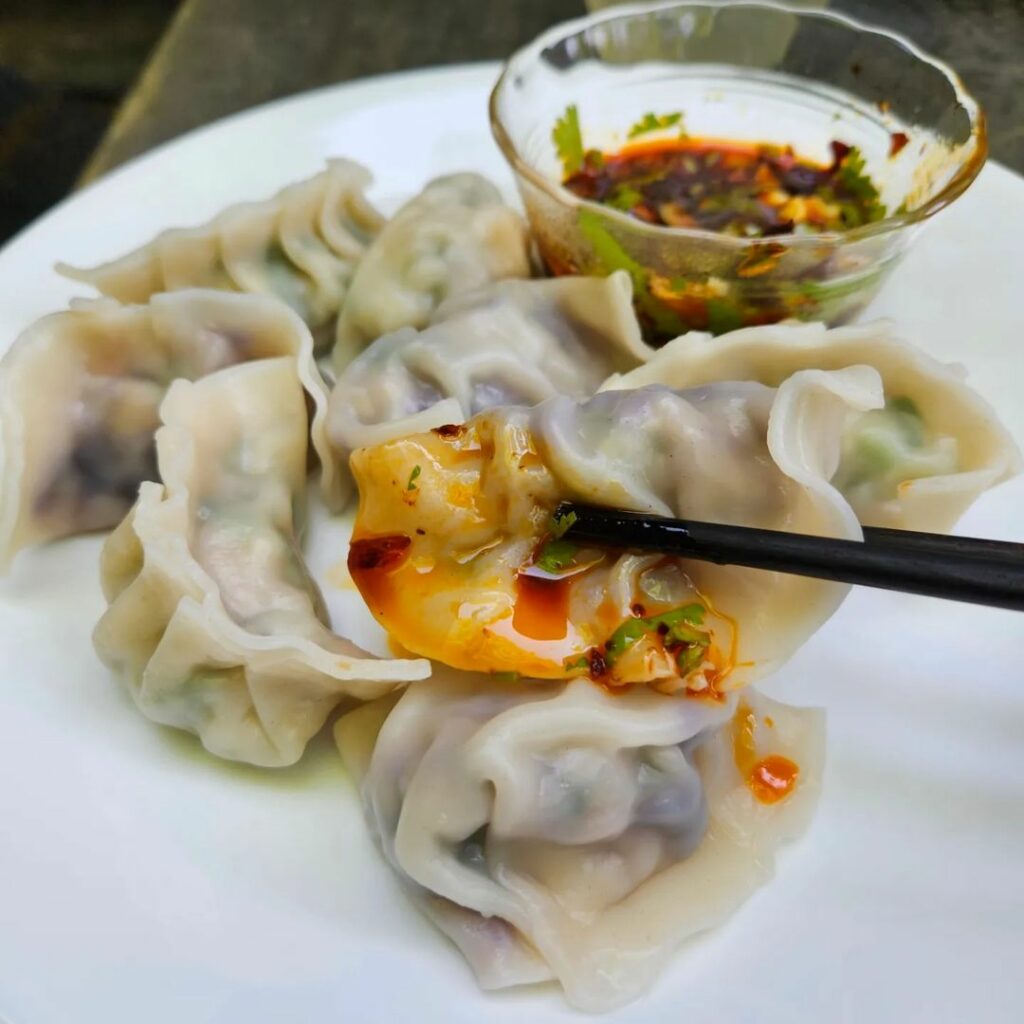
Jiaozi, hailed as the quintessential Chinese dumplings, originate from Northern China. They are made with a simple dough of flour and water, filled with a wide range of ingredients like minced pork, vegetables, shrimp, or a combination.
Jiaozi can be boiled, steamed, or pan-fried, each method offering a unique texture and flavor. These dumplings hold great cultural significance, particularly during Chinese New Year, symbolizing wealth and good fortune. They are traditionally served in a round shape, representing the unity of the family.
Wonton: Savory Delights from Southern China
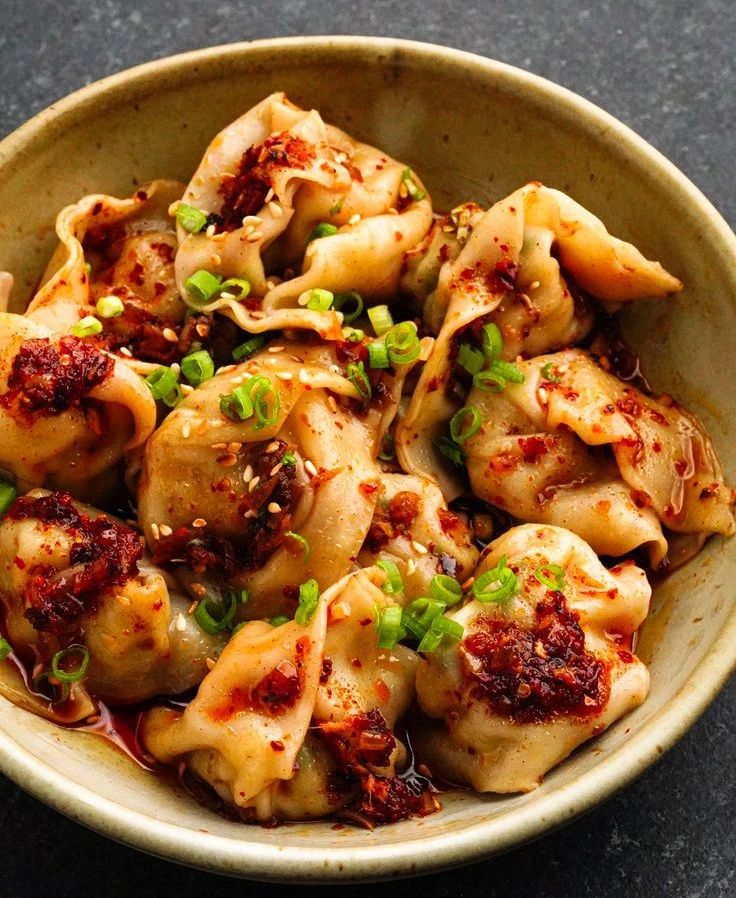
Wontons are popular dumplings originating from Southern China. They feature delicate, thin wrappers filled with a variety of ingredients such as seasoned minced meat, shrimp, or a mixture of both. Wontons are often enjoyed in a flavorful broth, making them a comforting soup-based dish.
Regional specialties include Cantonese-style wonton noodle soup, where wontons are served with springy noodles and a fragrant broth. The distinct combination of fillings and thin wrappers sets wontons apart.
Shui Jiao: Boiled Dumplings for All Seasons
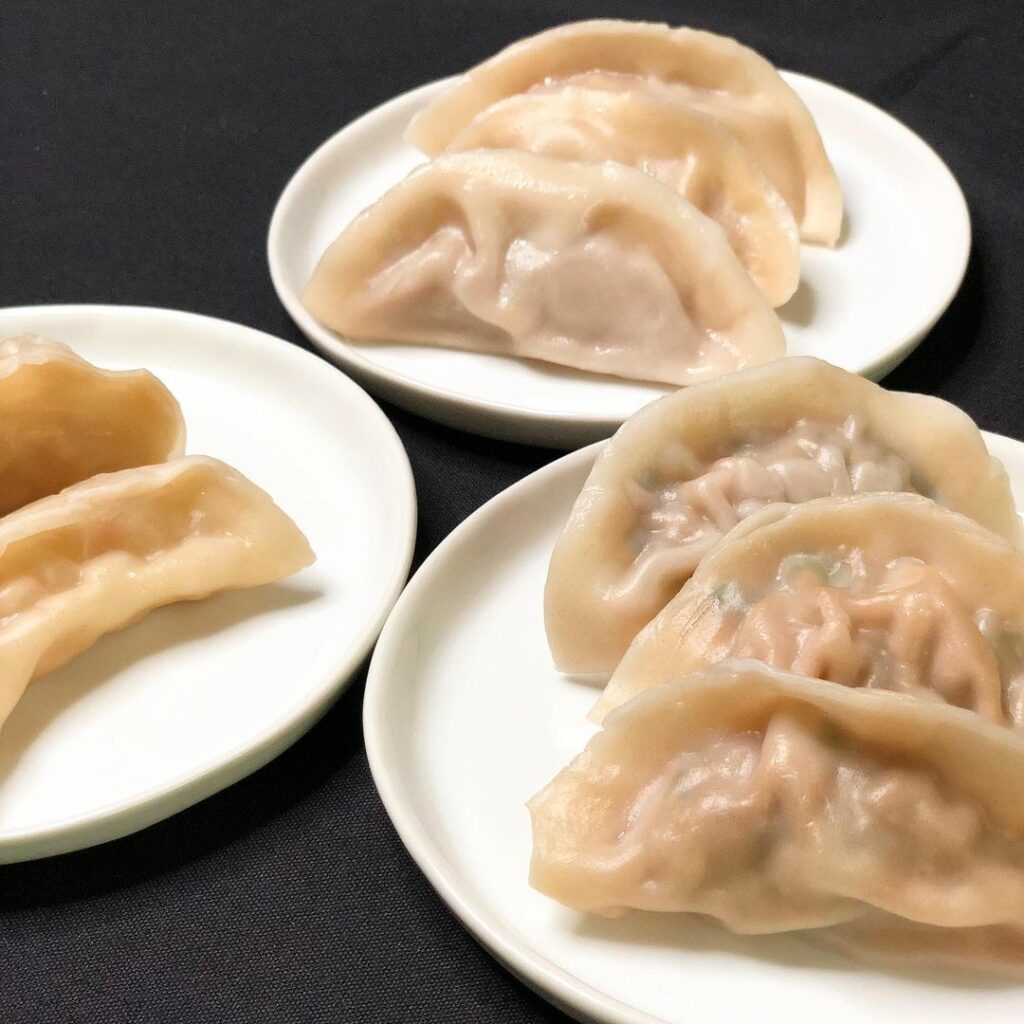
Shui Jiao, or boiled dumplings, are a versatile type of Chinese dumpling enjoyed throughout the year. They come in different shapes, including crescent-shaped or folded rectangles. The fillings can be diverse, ranging from pork and cabbage to lamb, seafood, or vegetarian options.
Shui Jiao is typically served with various dipping sauces, such as soy sauce, vinegar, chili oil, or a combination, enhancing their flavors. These boiled dumplings are beloved for their comforting and satisfying qualities.
Guo Tie: Crispy and Juicy Pan-Fried Dumplings
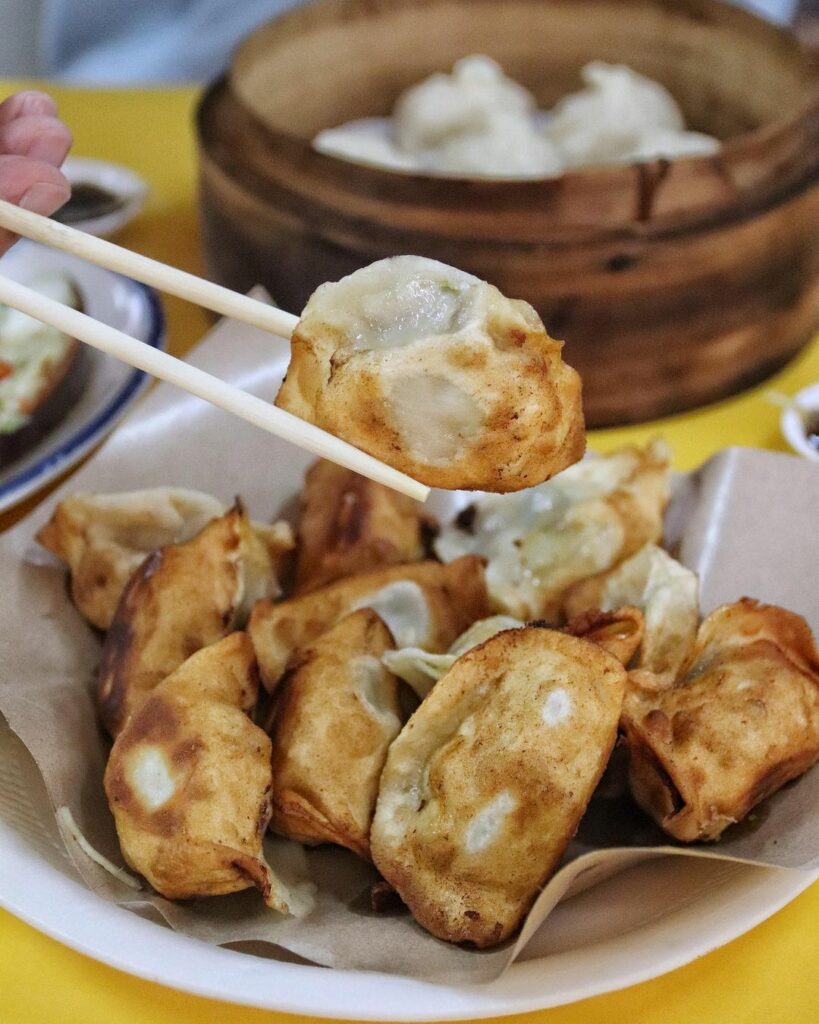
Guo Tie, also known as potstickers, are a delightful variation of Chinese dumplings that are pan-fried to achieve a crispy bottom and juicy filling. They are made with a similar dough and filling as jiaozi, but the cooking technique sets them apart.
Guo Tie are first pan-fried to create a crispy golden crust, then steamed to ensure the filling is cooked through. They are often served with a dipping sauce like soy vinegar or a spicy chili oil. Regional variations exist, showcasing unique flavors and accompanying condiments.
Specialized dumplings
Tang Yuan: Sweet Glutinous Rice Balls
Tang Yuan are delightful sweet dumplings made from glutinous rice flour. They are commonly enjoyed as a festive dessert during important occasions such as the Lantern Festival and Winter Solstice.
Tang Yuan comes in various fillings, such as sweet sesame paste, red bean paste, or crushed peanuts. These dumplings symbolize family unity and harmony. They are traditionally served in a sweet broth and are associated with warm gatherings and joyful celebrations.
Shaomai: Elegant Open-Top Dumplings
Shaomai are elegant and open-top dumplings that are popular throughout China. They are characterized by their unique pleated shape and exposed filling at the top. Shaomai fillings often consist of a combination of minced meat (such as pork or chicken), shrimp, mushrooms, and bamboo shoots.
Regional variations of shaomai exist, each showcasing their own ingredients and flavors. They are typically served with a variety of dipping sauces, such as soy sauce, chili oil, or a tangy vinegar-based sauce.
Lion’s Head Meatballs: Hearty Dumplings from Jiangsu
Lion’s Head Meatballs, originating from Jiangsu province, are hearty and flavorful dumplings known for their large size and unique appearance. These meatballs are made by combining ground pork with various seasonings and ingredients.
They are shaped into large, round meatballs, symbolizing a lion’s head. The meatballs are typically braised or steamed in a savory broth with cabbage or other vegetables, resulting in tender and succulent meat. They are often served as a centerpiece dish during festive occasions and family gatherings.
Zongzi: Pyramid-Shaped Rice Dumplings with Indulgent Fillings
Zongzi are pyramid-shaped rice dumplings wrapped in bamboo leaves. They are traditionally eaten during the Dragon Boat Festival to commemorate the poet Qu Yuan. Zongzi is made by stuffing glutinous rice with various fillings, such as pork belly, salted egg yolk, peanuts, or red bean paste.
The filled rice parcels are then tightly wrapped in bamboo leaves and steamed or boiled. These dumplings carry cultural significance and are associated with protection against evil spirits. Zongzi has regional preferences and variations in ingredients, wrapping methods, and flavors.
Fusion and modern dumplings
Soup-filled Dumplings: Innovative Twists on Xiaolongbao
Soup-filled dumplings offer innovative twists on the traditional xiaolongbao. These dumplings feature creative fillings and variations, expanding beyond the classic pork and soup combination.
From truffle-infused broths to unexpected flavors like crab or cheese, soup-filled dumplings have gained popularity for their delightful bursts of flavor. Notable establishments specializing in these innovative dumplings have emerged, showcasing the culinary ingenuity and pushing the boundaries of traditional soup dumplings.
Dessert Dumplings: Sweet Delicacies for the Adventurous
For the adventurous dessert lovers, there is a fascinating world of unconventional dessert dumplings to explore. These dumplings break the traditional savory mold and introduce unique sweet flavors, ingredients, and presentation styles.
From fruit-filled dumplings with tangy sauces to chocolate or matcha-infused dumplings with decadent fillings, dessert dumplings offer a delightful fusion of textures and tastes. They have become a trendy and indulgent treat for those seeking a sweet twist on the traditional dumpling.
Vegetarian and Vegan Dumplings: Plant-Based Delights
Vegetarian and vegan dumplings have gained popularity as more people embrace plant-based diets. These dumplings offer delicious alternatives made without meat or animal products, showcasing the versatility of plant-based ingredients.
Fillings often include a combination of vegetables, tofu, mushrooms, or textured vegetable protein. From classic vegetable dumplings to innovative creations, there are numerous options available for veggie lovers. Recipes and establishments catering to vegetarian and vegan dumplings have flourished, providing a delectable array of plant-based delights.
Regional dumpling specialties
Cantonese Dim Sum: Steamed and Pan-Fried Dumplings
Cantonese dim sum offers a tantalizing variety of steamed and pan-fried dumplings. These bite-sized delicacies are a hallmark of Cantonese cuisine. Highlights include delicate har gow (shrimp dumplings), siu mai (pork and shrimp dumplings), and crispy fried dumplings.
Dim sum dining is a vibrant experience, with a wide array of small dishes served on bamboo steamers. Dim sum etiquette encourages sharing and sampling a variety of flavors, making it a social and interactive dining experience.
Sichuan Spicy Dumplings: Fiery and Flavorful
Sichuan dumplings are known for their fiery and flavorful profiles. Influenced by the bold flavors of Sichuan cuisine, these dumplings often feature a numbing and spicy combination of ingredients. Notable ingredients include Sichuan peppercorns, chili oil, garlic, and various aromatic spices.
Cooking techniques like chili oil-infusion or dry frying enhance the flavors further. Sichuan spicy dumplings offer a thrilling culinary experience for those seeking intense and vibrant taste sensations.
Shanghai Soup Dumplings: Delicate Pleasures
Shanghai is famous for its exquisite soup dumplings, known as xiaolongbao. These delicate dumplings are crafted with thin, pleated wrappers and filled with a combination of minced meat and rich, flavorful broth.
The art of making xiaolongbao lies in achieving a perfect balance between the thin skin and the juicy filling. Each bite releases a burst of savory broth, creating a delightful sensory experience. Shanghai offers a variety of xiaolongbao flavors and fillings, showcasing its own regional variations.
Hubei Three-Cornered Dumplings: A Taste of Central China
Hubei province is known for its distinctive three-cornered dumplings, also known as sanxian doupi. These dumplings are characterized by their unique triangular shape, made by folding a square dough wrapper.
They are typically filled with a mixture of ground meat, mushrooms, and other flavorful ingredients. Three-cornered dumplings hold cultural significance and are often enjoyed during festivals and special occasions in Hubei province. They offer a taste of Central China’s culinary heritage and are a delightful representation of the region’s dumpling traditions.
Xinjiang Lamb Dumplings: Savory Delights from the West
Xinjiang, a region in Western China, is known for its savory lamb dumplings. Influenced by Central Asian cuisine, Xinjiang dumplings feature aromatic spices, flavorful minced lamb, and herbs.
These dumplings are often accompanied by a tangy yogurt sauce, adding a creamy and refreshing element to the dish. Xinjiang lamb dumplings showcase the unique flavors and culinary influences from the region’s multicultural heritage, resulting in a savory delight that captures the essence of Western Chinese cuisine.
Lesser-known dumplings
Jian Dui: Crispy Fried Sesame Balls
Jian Dui, also known as sesame balls, are popular Chinese dessert dumplings. These delightful treats feature a crispy fried exterior made from glutinous rice flour and a sweet filling, often red bean paste or lotus seed paste. After frying, the dumplings develop a beautiful golden color and a satisfying crunch. Jian Dui holds cultural associations with good luck and prosperity, making them a common sight during festive occasions like Chinese New Year. They are a delicious combination of textures and flavors, showcasing the indulgent side of Chinese dumplings.
Eight-Treasure Dumplings: Festive and Flavorful
Eight-Treasure Dumplings are a festive and flavorful dumpling with symbolic significance. The dumplings are typically made during special occasions and celebrations. The number “eight” represents good fortune in Chinese culture.
These dumplings are filled with a combination of eight treasure ingredients, which can include various nuts, dried fruits, sweet bean paste, and candied peels. The preparation involves wrapping the filling in a sticky rice dough and steaming it. Eight-Treasure Dumplings are not only visually appealing but also carry the meaning of abundance and prosperity.
Guo Kui: Pan-Fried Dumplings with Crispy Layers
Guo Kui is a delightful Chinese dumpling delicacy known for its crispy and flaky layers. These dumplings are made from a wheat-based dough that is rolled out and folded repeatedly to create thin layers.
They are then pan-fried until golden and crispy on the outside. Guo Kui can be filled with a variety of savory ingredients such as minced meat, vegetables, or even pickled items. Regional variations exist, each showcasing unique fillings and flavors. The result is a satisfying dumpling with a delightful contrast of textures and a burst of savory flavors.
How do I store and reheat leftover dumplings?
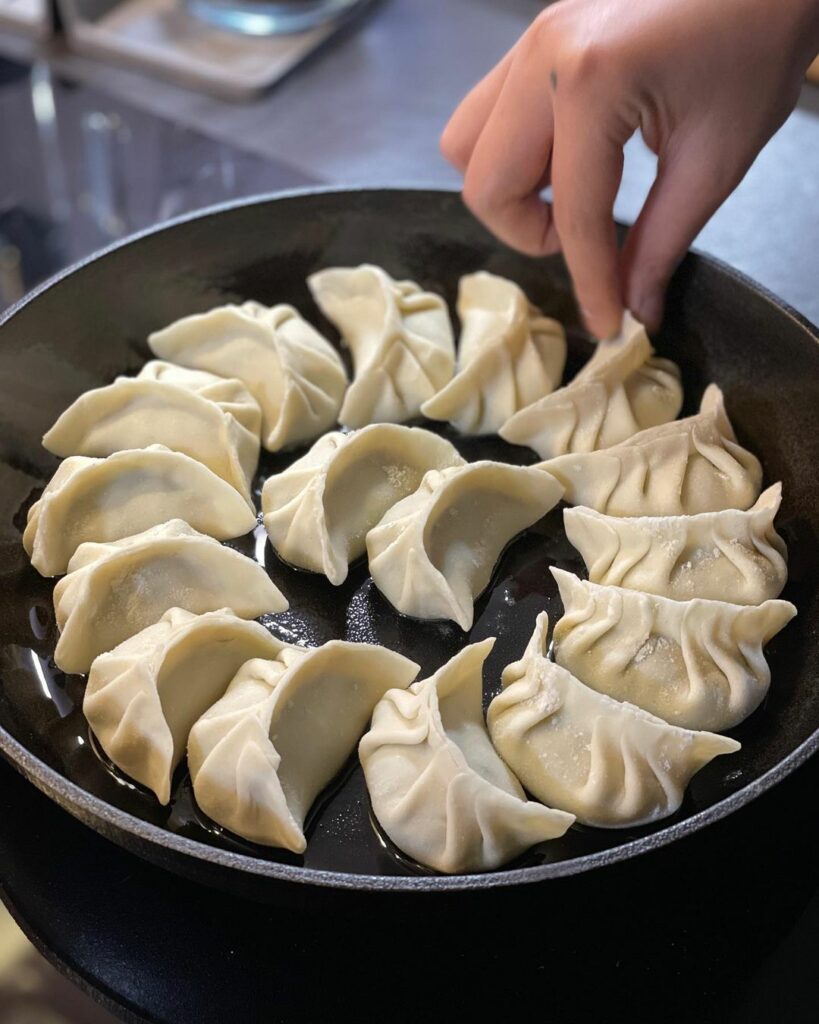
To store leftover dumplings
- Allow the dumplings to cool down to room temperature.
- Place the dumplings in an airtight container or wrap them tightly with plastic wrap.
- Store the dumplings in the refrigerator for up to 2-3 days.
To reheat leftover dumplings
- Steaming: Place the dumplings in a steamer and steam them for about 5-8 minutes until they are heated through.
- Pan-frying: Heat a non-stick pan over medium heat, add a small amount of oil, and place the dumplings in the pan. Cook for a few minutes until the bottoms are crispy, then add a splash of water and cover the pan with a lid to steam the dumplings for a few more minutes until heated through.
- Boiling: Bring a pot of water to a boil and add the dumplings. Cook for 3-5 minutes until they float to the surface and are heated.
- Leftover dumplings can also be frozen for longer storage. Place the dumplings in a single layer on a baking sheet lined with parchment paper and freeze until firm, then transfer them to a freezer bag or airtight container. Frozen dumplings can be cooked directly from frozen using the same methods mentioned above, with slightly longer cooking times.
Read more: How Long To Boil Dumplings? The Ultimate Guide
What are the health benefits and risks of Chinese dumplings?
Health benefits
- Nutritional Balance: Chinese dumplings can provide a balanced combination of proteins, carbohydrates, and vegetables, depending on the filling. They can be a source of essential nutrients, including vitamins, minerals, and dietary fiber.
- Protein Source: Dumplings often contain meat or seafood fillings, which can provide a good source of protein, essential for muscle growth and repair.
- Vegetable Intake: Many dumpling recipes include vegetables, such as cabbage, mushrooms, or chives, which contribute to the overall nutritional value by adding vitamins, minerals, and fiber.
Risks associated
- Caloric Content: Depending on the cooking method (steamed, boiled, or pan-fried) and the filling ingredients, Chinese dumplings can vary in calorie content. Pan-fried dumplings, for example, may be higher in calories due to the added oil.
- Sodium Content: Some dumpling fillings and sauces can contain high levels of sodium, which may be a concern for individuals with high blood pressure or sodium-restricted diets.
- Allergies and Sensitivities: Dumplings often contain common allergens such as wheat, soy, shellfish, or other ingredients that can trigger allergic reactions or food sensitivities in some individuals.
- Food Safety: Improper handling, storage, or preparation of dumplings can pose food safety risks, such as the potential for bacterial contamination if not cooked thoroughly or stored at appropriate temperatures.
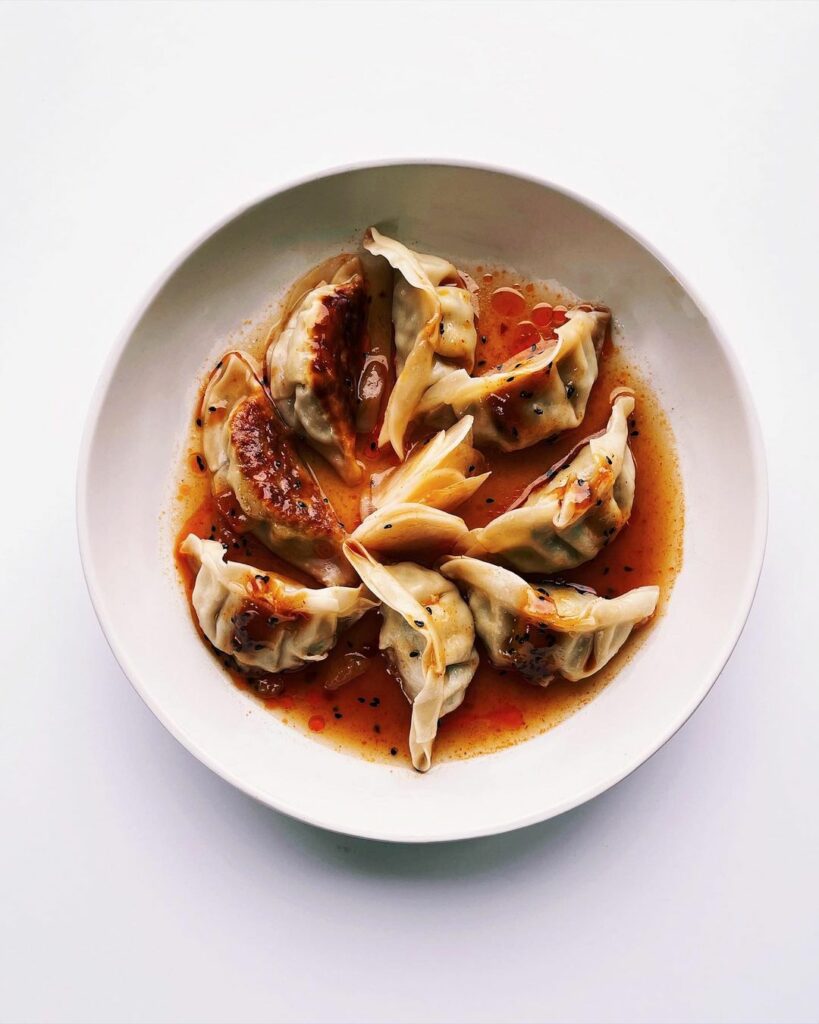
FAQs
What is the best way to fold dumplings?
The best way to fold dumplings is by following the classic pleating method. Here’s a step-by-step guide:
- Place a spoonful of filling in the center of the dumpling wrapper.
- Moisten the edge of the wrapper with water or egg wash to help with sealing.
- Fold the wrapper in half, creating a half-moon shape, and press the edges together to seal.
- Starting from one end, use your thumb and index finger to create a pleat on one side of the wrapper.
- Fold the pleat towards the center and press it firmly against the opposite edge.
- Repeat this pleating process, working your way around the edge of the dumpling, until it is completely sealed. Aim for around 5-6 pleats on each side, depending on the size of the wrapper.
- With practice, you’ll develop your own technique and style for folding dumplings. The key is to ensure a tight seal to prevent any filling from leaking during cooking.
Can I make dumplings with gluten-free dough?
Regarding gluten-free dumpling dough, yes, it is possible to make dumplings with gluten-free dough. Instead of using wheat flour, you can use a gluten-free flour blend that is suitable for dumpling wrappers. The texture and elasticity of the dough may be slightly different from the traditional wheat-based dough, so it’s important to follow a gluten-free dumpling recipe specifically tailored for gluten-free flour.
Gluten-free dumpling dough may require different amounts of water or additional binding ingredients to achieve the desired consistency. Experimenting with different gluten-free flour blends and recipes will help you find the best results for making dumplings without gluten.
Can you freeze dumplings for later use?
Yes, you can freeze dumplings for later use. Freezing dumplings is a convenient way to preserve them for future meals or to make them in advance for busy days. Here’s how you can freeze dumplings:
- Assemble the dumplings: Prepare the dumplings as you normally would, shaping and filling them.
- Arrange on a tray: Place the assembled dumplings on a baking sheet or tray lined with parchment paper, making sure they are not touching each other.
- Freeze until firm: Put the tray of dumplings in the freezer and allow them to freeze until firm. This usually takes a couple of hours.
- Transfer to storage: Once the dumplings are frozen, transfer them to a freezer-safe bag or airtight container. Label the container with the date and contents.
- Store in the freezer: Place the bag or container of dumplings in the freezer and store them for up to 2-3 months.
What is the difference between jiaozi and wonton?
Certainly! Here’s a table highlighting the main differences between jiaozi and wonton:
| Jiaozi | Wonton |
| Originates from Northern China | Originates from Southern China |
| Generally larger in size | Smaller in size |
| Thicker dough wrapper | Thinner dough wrapper |
| Can be boiled, steamed, or pan-fried | Usually boiled or served in soup |
| Fillings often include meat and veggies | Fillings often include meat or seafood |
| More variety in fillings and flavors | Limited variety in fillings |
| Often pleated and folded into a crescent shape | Typically folded into a triangle shape |
| Popular during Chinese New Year and other celebrations | Commonly enjoyed as a part of dim sum |
This table provides a quick overview of the key distinctions between jiaozi and wonton, including their regional origins, size, dough thickness, cooking methods, fillings, shapes, and culinary contexts.
Are Chinese dumplings always savory?
Chinese dumplings are commonly associated with savory fillings, but they can also be prepared as sweet dumplings. Here’s a breakdown of the savory and sweet variations:
Savory Chinese Dumplings:
- The majority of Chinese dumplings are savory and filled with ingredients like ground meat (pork, beef, chicken), seafood (shrimp, crab), vegetables (cabbage, mushrooms, carrots), and various seasonings.
- Savory dumplings are often seasoned with soy sauce, ginger, garlic, sesame oil, and other spices to enhance the flavor of the filling.
- They are typically served as a main course or as part of a meal, accompanied by dipping sauces or in soups.
Sweet Chinese Dumplings:
- Sweet dumplings are less common but still enjoyed in Chinese cuisine.
- Sweet fillings can include ingredients like red bean paste, lotus seed paste, black sesame paste, taro, sweet potato, or fruits.
- Sweet dumplings may be steamed, boiled, or even deep-fried, depending on the specific type and regional variation.
- They are often served as desserts or snacks, and can be enjoyed on their own or accompanied by a sweet syrup or sauce.
In Chinese cuisine, both savory and sweet dumplings have their place, and the choice between them depends on personal preferences and the occasion.
How are Chinese dumplings traditionally served?
Traditionally, Chinese dumplings are served in a variety of ways:
- Boiled: Dumplings are cooked by boiling them in water until they float to the surface. They are then typically served in a bowl or on a plate with dipping sauces on the side.
- Steamed: Dumplings are placed in a steamer basket or bamboo steamer and cooked by steam until they are fully cooked, and the wrappers become translucent. Steamed dumplings are usually served on small plates or bamboo steamers.
- Pan-Fried: Dumplings can be pan-fried after boiling to create a crispy bottom. They are cooked in a pan with a bit of oil until the bottom becomes golden and crispy while maintaining a soft top. Pan-fried dumplings are often served with a dipping sauce.
The specific serving style may vary based on the type of dumpling, regional customs, and personal preferences.
How do I fold and pleat Chinese dumplings?
Folding and pleating Chinese dumplings may vary based on the desired shape and regional traditions. Here is a basic method to fold and pleat Chinese dumplings:
- Step 1: Place a small amount of filling in the center of the dumpling wrapper.
- Step 2: Moisten the edges of the wrapper with water to help seal the dumpling.
- Step 3: Fold the dumpling in half, creating a half-moon shape, and press the edges together to seal.
- Step 4: Starting from one end, pinch and fold the edge of the wrapper, creating a pleat. Press the pleat firmly against the opposite edge to seal. Repeat this process, creating additional pleats until the dumpling is fully sealed.
- Step 5: Ensure the dumpling is well-sealed by pressing the edges together firmly, making sure no filling escapes during cooking.
Are there any famous street food dumplings in China?
China is renowned for its diverse street food culture, and dumplings play a significant role in it. Some famous street food dumplings in China include:
- Shengjianbao: Originating from Shanghai, these are pan-fried dumplings with a thick, doughy exterior and juicy filling. They are often topped with sesame seeds and chopped green onions.
- Baozi: Steamed buns, known as baozi, are popular street food items found throughout China. They come in various fillings, including pork, beef, chicken, and vegetarian options.
- Jianbing: While not strictly a dumpling, jianbing is a famous Chinese street food item. It is a thin, crepe-like pancake filled with a combination of ingredients such as egg, scallions, cilantro, bean paste, and crispy wonton wrappers.
- Xiaolongbao: These soup dumplings are not exclusively street food, but they are commonly found in street food markets and bustling food stalls. Xiaolongbao are delicate steamed dumplings filled with flavorful broth and meat, often enjoyed with a dipping sauce.
Are Chinese dumplings typically served with dipping sauces?
Yes, Chinese dumplings are typically served with dipping sauces to enhance their flavor. Dipping sauces can vary based on personal preferences and regional traditions. Some common dipping sauces for Chinese dumplings include:
- Soy sauce: Regular soy sauce or a combination of soy sauce and vinegar.
- Black vinegar: Often mixed with soy sauce, ginger, and garlic for a tangy and savory flavor.
- Chili oil: Spicy chili oil or chili sauce adds heat and flavor.
- Sesame sauce: Made from toasted sesame seeds and combined with soy sauce, vinegar, and other seasonings.
These sauces can be served individually or as a combination, allowing diners to customize the flavor according to their taste.
Are Chinese dumplings considered an appetizer or a main course?
Chinese dumplings can be enjoyed as both appetizers and main courses, depending on the context and the accompanying dishes. In a typical Chinese meal, dumplings may be served as part of a multi-course feast, where they are one of many dishes shared among the diners. In this case, they are considered appetizers.
However, Chinese dumplings can also be the centerpiece of a meal, especially when served in larger quantities or combined with other side dishes. They can be a satisfying and filling main course option, particularly if served with rice or noodles.
Whether Chinese dumplings are considered an appetizer or a main course depends on the dining style, portion sizes, and the overall composition of the meal.
Can Chinese dumplings be baked?
Chinese dumplings are traditionally boiled, steamed, or pan-fried. Baking is not a common cooking method for Chinese dumplings. However, there are some variations and fusion recipes where dumplings are baked. These baked dumplings often have a different name and may not adhere to the traditional Chinese dumpling style.
If you prefer a baked version, you can experiment with adapting dumpling fillings and wrappers to a baking-friendly recipe. However, it’s important to note that the texture and taste of baked dumplings may differ from the traditional methods of cooking, as baking may not provide the same level of moisture retention or the desired dumpling texture.
Conclusion
Bluntly stated, exploring the diverse world of Chinese dumplings reveals a rich tapestry of flavors, fillings, cooking techniques, and regional specialties. The wide array of types of Chinese dumplings, from the iconic jiaozi to the delicate xiaolongbao, showcases the culinary artistry and cultural significance of this beloved dish. Each type of dumpling carries its own unique story, reflecting the history, traditions, and tastes of different regions in China.
Whether you prefer the savory delights of northern-style jiaozi, the fiery flavors of Sichuan spicy dumplings, or the delicate pleasures of Shanghai soup dumplings, there is a dumpling to satisfy every palate.
Types of Chinese dumplings not only bring people together at the dining table but also serve as a window into the rich heritage and culinary traditions of Chinese cuisine. So, embrace the variety, indulge in the flavors, and savor the cultural journey that Types of Chinese Dumplings have to offer.